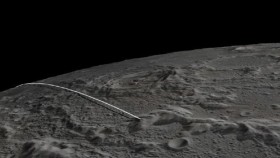
After completing their successful mission of mapping the moon’s gravity to the micron, two NASA lunar orbiters were deliberately sent to crash into the surface of the moon, ending their robotic lives on a mountain near the north pole.
Engineers commanded the twin spacecraft, Ebb and Flow, to fire their engines and burn their remaining fuel. Ebb plunged first, slamming into a mountain near the moon’s north pole on Monday. Its twin, Flow, followed about a half minute later and aimed for the same target.
The site was located far away from any previous landing sites, so as to not cause any damage to these historical places.
After the double impacts, mission chief scientist Maria Zuber of the Massachusetts Institute of Technology said the spot had been named after team member Sally Ride, the first American woman in space, who died earlier this year.
“It’s really cool to know that when you look up now at the moon there’s this little corner of the moon that’s named after Sally,” said Ride’s sister, Rev. Bear Ride.
Unfortunately, the final crash site was not visible from Earth, as it was in darkness at the time. However, the Lunar Reconnaissance Orbiter circling the moon will pass over the mountain and attempt to photograph the skid marks left by the washing machine sized-spacecraft as they hit the surface at over 6,000 km/h.
After rocketing off the launch pad in September 2011, Ebb and Flow took a roundabout journey to the moon, arriving over the New Year’s holiday on a US$487 million gravity-mapping mission.
Ebb and Flow focused exclusively on measuring the moon’s lumpy gravity field – to the micron – in a bid to learn more about its interior and early history. After flying in formation for months, they produced the most detailed gravity maps of any body in the solar system.
Obtaining precise gravity calculations required the twins to circle low over the moon, which consumes a lot of fuel. During the primary mission, they flew about 60 km above the lunar surface.
The data collected on the mission showed that the lunar crust is much thinner than scientists had imagined, and that it was severely battered by asteroids and comets in the early years of the solar system – much more than previously realised.
Data so far also appears to disprove the theory that Earth once had two moons that collided and melded into the one we see today. Scientists expect to sift through data from the mission for years.







